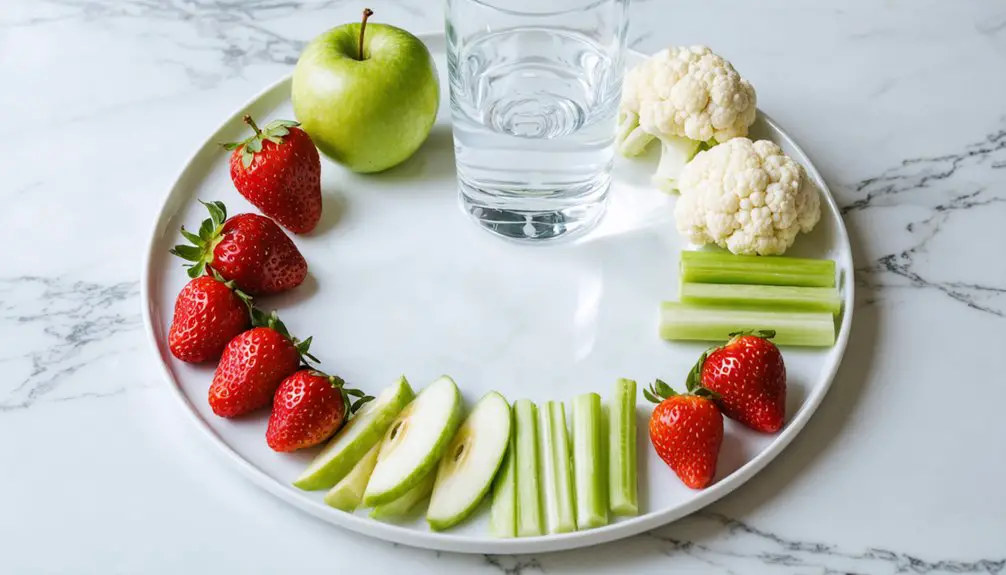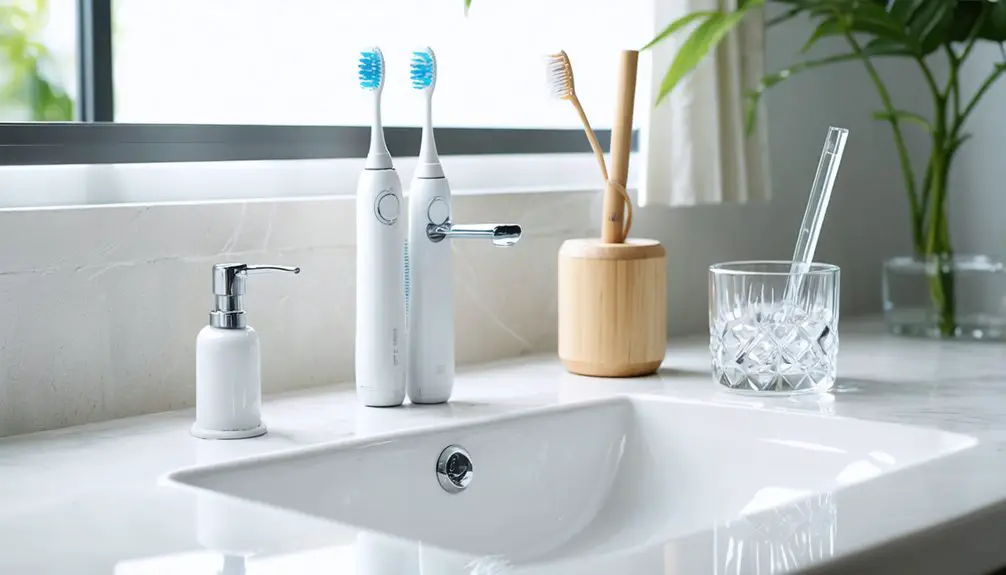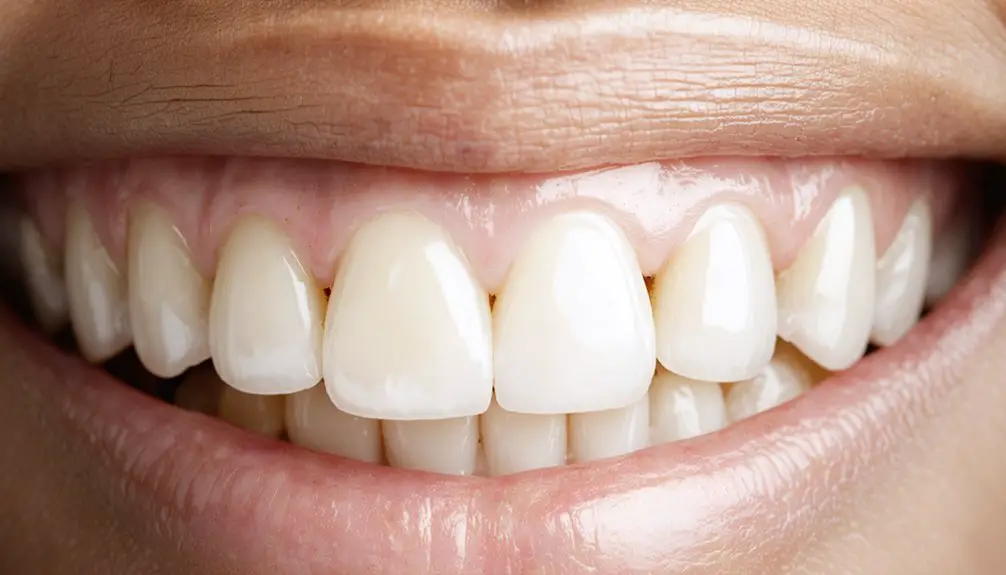To maintain your teeth whitening results, you’ll need to implement both daily care and preventive measures. Brush twice daily with whitening toothpaste, floss regularly, and rinse immediately after consuming staining beverages. Use a straw when drinking dark liquids, and focus on eating light-colored foods. Schedule professional cleanings every six months, and consider touch-up treatments annually. Understanding the science behind whitening longevity will help you optimize your maintenance routine.
Key Takeaways
- Brush twice daily with whitening toothpaste and use a soft-bristled toothbrush to maintain brightness while protecting enamel.
- Rinse mouth immediately after consuming staining beverages and use a straw when possible to minimize contact with teeth.
- Schedule professional dental cleanings every six months and plan touch-up treatments annually to maintain whitening results.
- Avoid dark-colored foods and beverages for at least 48 hours post-treatment and minimize consumption thereafter.
- Maintain consistent flossing habits to prevent plaque buildup and staining between teeth.
The Science Behind Teeth Whitening Durability
When teeth whitening products release oxygen molecules into the enamel, they trigger a complex oxidation process that breaks down chromophores responsible for discoloration.
The whitening chemistry involves hydrogen peroxide as the primary agent, which penetrates your tooth structure to achieve a brighter appearance. Modern research confirms that lower peroxide concentrations are equally effective while reducing sensitivity risks. Research shows that tooth sensitivity affects between 15-78% of patients during treatment.
Understanding the durability of your results requires knowledge of enamel alteration during treatment. While the process effectively whitens teeth, it can modify your enamel’s microstructure.
Clinical studies show that results typically remain stable for up to six months, though individual responses vary. The concentration of whitening agents plays a significant role – higher concentrations used in professional treatments work more quickly but don’t necessarily provide longer-lasting results than consistent at-home treatments.
Your oral environment and mineral content also influence how long the whitening effects persist.
Daily Habits That Protect Your Bright Smile
After investing time and money in teeth whitening, maintaining your bright smile requires consistent daily habits and preventive measures.
Your daily oral care routine should include proper flossing techniques, reaching between each tooth to remove debris that can lead to staining. Select a soft-bristled toothbrush, either manual or electric, and brush thoroughly twice daily with fluoride toothpaste. Using desensitizing toothpaste can help create a protective barrier and reduce discomfort after whitening treatments.
Effective oral hygiene requires thorough flossing and brushing with fluoride toothpaste using a soft-bristled toothbrush to prevent stains and discoloration.
To protect your whitening results, rinse your mouth with water after consuming staining beverages like coffee or red wine, and use a straw when possible. Eating crunchy fruits and vegetables can naturally help clean your teeth throughout the day.
Consider incorporating whitening toothpaste into your routine twice weekly for maintenance. Minimize exposure to tobacco products and dark-pigmented foods that can compromise your results.
Regular dental check-ups every six months will help monitor your whitening success and maintain peak oral health through professional cleanings.
Strategic Dietary Choices for Lasting Whiteness

Beyond daily oral care habits, your dietary choices directly influence the longevity of your teeth whitening results. To maintain your bright smile, implement strategic pigment avoidance strategies for at least 48 hours post-treatment, focusing on white or light-colored foods like chicken, fish, rice, and plain yogurt. Your teeth are porous after whitening treatment, making them especially vulnerable to staining agents.
Your whitening food choices should exclude dark fruits, brightly colored vegetables, and acidic items that can compromise enamel integrity. Avoid tomato-based products, turmeric, soy sauce, and artificially colored foods that risk staining your newly whitened teeth. Using a straw for beverages can help minimize contact with teeth and reduce staining potential.
Instead, opt for light-colored fruits like bananas and pears, and vegetables such as cauliflower and potatoes. Stay hydrated with water to help flush away potential staining agents and support enamel remineralization during this critical period.
Professional Care and Maintenance Routines
Maintaining professional dental care routines plays an essential role in extending the lifespan of your teeth whitening results. Schedule cleanings every six months to remove stubborn tartar and surface stains that regular brushing can’t eliminate.
Your dental hygienist will use specialized tools to preserve your enamel’s brightness while preventing discoloration. Regular dental checkups are crucial for monitoring your whitening progress and addressing any concerns early.
Regular hygiene visits employ professional-grade instruments designed to maintain your smile’s radiance while safeguarding against new stains and discoloration.
For ideal results, plan professional touch-ups once or twice yearly, depending on your lifestyle factors and initial whitening method. Your dentist will determine the most suitable maintenance schedule for your needs.
Protect your enamel by using a soft-bristled toothbrush and avoiding aggressive brushing techniques, especially within 48 hours post-treatment when teeth are most vulnerable.
If you experience sensitivity, ask your dentist about desensitizing treatments that won’t compromise your whitening results. Professional whitening treatments offer more dramatic results than any at-home methods available.
At-Home Touch-Up Techniques
You’ll maximize your whitening results by using custom-fitted trays with peroxide gel for 2-4 hours daily or overnight, following your dentist’s recommended maintenance schedule.
For convenient touch-ups between tray treatments, apply whitening strips for 20-30 minutes daily over a 1-2 week period, ensuring proper adhesion for even results. Consider supplementing with LED light kits to enhance the effectiveness of your at-home whitening routine. Regular use helps achieve optimal results through the oxidation process that breaks down stubborn stains.
To prevent new stains from developing, maintain consistent oral hygiene with whitening toothpaste 1-2 times weekly, rinse promptly after consuming staining beverages, and stay hydrated throughout the day.
Custom Tray Maintenance Tips
Professional care of custom whitening trays is essential for achieving consistent, long-lasting results during at-home touch-up treatments.
You’ll need to clean your trays thoroughly after each use with an electric toothbrush and non-perfumed soap, avoiding toothpaste which can damage the material. Always dry them with a soft cloth before storage.
Store your trays in a protective case in a cool, dry place, away from direct sunlight to maintain their shape.
For ideal gel application, verify both trays and teeth are clean and dry, then apply small drops of gel for each tooth rather than filling the entire tray.
You can extend your trays’ lifespan by using effervescent cleaning tablets periodically to remove buildup and regularly inspecting them for signs of wear or damage.
Whitening Strip Best Practices
For ideal whitening results, proper application of whitening strips requires meticulous attention to technique and timing.
Start with clean, dry teeth but don’t brush immediately before application. Align the strip’s gel side carefully along your gum line, pressing firmly to eliminate air bubbles and folding excess material behind teeth for secure placement.
To maintain strip effectiveness, store them at room temperature in their sealed packaging. You’ll achieve superior results by following the recommended schedule without overuse.
If you experience sensitivity, space out your applications or take brief breaks between treatments. Use whitening toothpaste between sessions to enhance and maintain results.
Remember to avoid staining foods and beverages immediately after whitening strip application, and schedule touch-ups every 6-12 months to preserve your brighter smile.
Daily Stain Prevention Methods
While whitening strips offer significant results, maintaining a bright smile requires consistent daily preventive measures.
Your brushing techniques should include using a soft-bristled or electric toothbrush at least twice daily with whitening toothpaste to effectively remove surface stains. The flossing importance can’t be overstated – daily flossing eliminates plaque and food particles between teeth that contribute to discoloration.
Replace your toothbrush every three months to maintain peak cleaning efficacy. After consuming staining substances, immediately rinse your mouth with water to prevent pigment adherence.
You’ll enhance protection by using fluoride-containing products to strengthen enamel against future staining. For ideal results, incorporate crunchy fruits and vegetables into your diet, as they naturally clean teeth while stimulating beneficial saliva production.
Understanding Your Personal Whitening Timeline

Understanding how long your teeth whitening results will last depends on several key variables, including your chosen treatment method, initial staining level, and lifestyle habits.
Your personal whitening expectations should align with treatment duration factors, as different methods yield varying timelines for results.
In-office professional treatments can show immediate changes within one session, while take-home trays require 1-2 weeks of consistent use.
If you have deep intrinsic staining, you’ll need more intensive treatment compared to surface stains.
The degree of whitening you’re seeking also impacts longevity – subtle changes typically last longer than dramatic transformations.
Without proper maintenance, results can fade within 4-6 weeks, but with good oral hygiene and stain prevention, your whitening effects can persist for 12-24 months.
Frequently Asked Questions
Can Teeth Become Resistant to Whitening Treatments Over Time?
No, your teeth don’t develop resistance to whitening treatments. Research shows treatment effectiveness depends on whitening frequency and external staining rather than biological tolerance to bleaching agents.
Is Teeth Whitening Safe During Pregnancy or While Breastfeeding?
You shouldn’t undergo teeth whitening during pregnancy or breastfeeding due to limited safety research. While risks aren’t definitively proven, potential pregnancy effects and lack of clinical evidence warrant waiting until after these periods.
Do Certain Medications Affect How Long Teeth Whitening Results Last?
Yes, your medication types greatly impact whitening efficacy. Tetracycline antibiotics, minocycline, and antihistamines can reduce your results’ longevity through intrinsic staining or by causing dry mouth that promotes re-staining.
Can Teeth Become Permanently Sensitive After Multiple Whitening Treatments?
You won’t typically experience permanent sensitivity with proper whitening frequency management. However, if you’re noticing prolonged discomfort, consult your dentist to evaluate potential underlying dental issues requiring attention.
Does Having Dental Work Affect Which Parts of Teeth Can Be Whitened?
Your dental work won’t whiten with standard whitening methods since restorative dental materials don’t respond to bleaching agents. Only your natural tooth enamel can be lightened, potentially creating color mismatches.
References
- https://wincrestorthodontics.com/how-long-does-teeth-whitening-last/
- https://www.dananigueldental.com/blog/teeth-whitening-results-longevity
- https://www.aspendental.com/dental-care-resources/how-long-does-teeth-whitening-last/
- https://www.huffmanfamilydentistry.com/the-durability-and-longevity-of-teeth-whitening-results/
- https://alphadental.net/blog/how-long-do-tooth-whitening-results-last-factors-that-affect-longevity/
- https://pmc.ncbi.nlm.nih.gov/articles/PMC10302806/
- https://pmc.ncbi.nlm.nih.gov/articles/PMC4058574/
- https://rsdjournal.org/rsd/article/view/45851
- https://www.nature.com/articles/4813423
- https://www.watforddentaloffice.ca/understanding-teeth-whitening-the-science-and-process/



